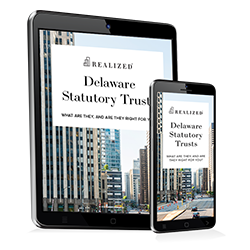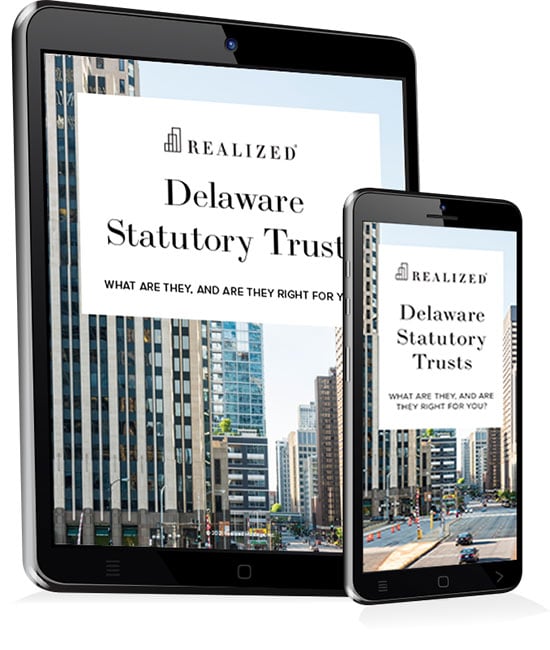Unlike a direct real estate investment, investing in a DST is less complicated. There isn’t any rehab that investors must spend money on. There are no closing costs. The cost-basis is easy to figure out. All of that helps simplify the Delaware Statutory Trust rate of return (RoR) calculation. In this article, we’ll dig into what you need to know about calculating the RoR on a DST.
Rate of Return Depends on Property Type
The properties a DST invests in determine the potential DST RoR investors can receive. A DST’s annual projected RoR can span 4-9%, while its total rate of return can far exceed this figure depending on the property’s ability to appreciate. In general, potential Delaware Statutory Trust returns will be lower for lower-risk properties, and for higher-risk properties, expected returns will be higher.
Some lower-risk properties include multifamily. Higher-risk properties include retail and industrial products. For both segments, property type alone doesn’t determine returns. Anyone who has invested in real estate knows that many factors drive returns.
Some of these factors include the location, local market, regulations, interest rates, and potential of the area. While returns on retail may be higher on average than multi-housing, a retail location in a booming part of town with high growth projections and a high-credit tenant may have returns equal to multi-housing. These lower returns result from the property's stability, which is another way of saying lower risk.
What Goes Into The DST Rate Of Return?
Once the above factors have been analyzed, two components determine the ROR for a DST. These are the annual rate of return, otherwise known as cash on cash (CoC) return, and appreciation, which is realized at the terminal event (i.e., sale of the property).
DSTs are not held indefinitely. Unlike direct real estate investments, where you might hold a property for 20 years or even until death, DST investments are terminal. Most have a lifespan of 5-10 years, but some may last longer. If everything goes well, your principal investment is returned to you at the end of the DST's life. If the DST experienced any appreciation in property values, that appreciation will pass through to you, and you'll realize an additional gain on your principal. This gain, a result of the terminal event, must be factored into the ROR, or total return in this case.
CoC
The objective of many DSTs is to pay distributions on a monthly basis. If you invest $500,000 in a DST that seeks to pay 5.5%, you could project an annual return of:
(5.5% x $500,000) = $27,500
This amount is called the CoC or cash on cash return. This is because it is based purely on the amount of cash you put into the investment and the amount of cash you’re receiving back on an annualized basis.
Delaware Statutory Trusts (DSTs) typically offer a cash-on-cash return of 5-9% per year, with the potential for additional appreciation. The overall return on a DST investment will depend on a number of factors, including the properties that the DST invests in, the management team, and overall market conditions.
Yield Vs. Rate Of Return
These two terms are sometimes used interchangeably. But there is a difference between them. It’s important to mention the differences to distinguish between the two. Also, ROI or return on investment is more commonly used in real estate than rate of return.
In the above example, we mentioned that the DST seeks to pay 5.5% per year. That is the DST’s distribution rate. Depending on the type of investment, different terms are for the cash distributions. For bonds, yield is used. But for DSTs, it is called the distribution rate. It is important to understand the differences.
The distribution rate is when cash flows, dividends, or distributions are involved during the holding period. Money doesn’t have to go back to the investor to be called a distribution rate. The investor can instead choose to reinvest the distributions.
Yield is a specific rate of return. Below, we calculate the total return, which is not a yield. It is the terminal event of the investment (i.e., sale or dissolution) and captures interest, capital gains, dividends, and realized distributions.
To sum up the differences, the rate of return can be the yield or total return. Yield is not the total return and is only present when distributions are made (whether to the invested or reinvested) during the holding period.
Total Return
In addition to cash flow, the total return includes any appreciation of your invested principal, which is tied to the appreciation of the DST's properties. If your initial basis appreciated a total of 20% over five years of holding, your principal will have increased to $600,000, or by $100,000.
We’ll add the cash flow to the appreciation to get the total return. We multiply our annual cash flow by 5 (years):
Total cash flow: $27,500 x 5 = $137,500
$100,000 appreciation + $137,500 of cash flow = $237,500
We now divide by the original amount invested:
$237,500 / $500,000 = 47.5%
This provides a total return of 47.5%.
But what about fees? Yes - we need to factor in the fees charged by the DST. Some DSTs will charge a fee upfront (i.e., load fee), and others will charge it on the back end (i.e., at time of sale). Upfront fees can range from 10% to 20% of the equity invested. These upfront fees are baked into your investment cost basis, which targeted monthly distributions are calculated off of - this means you aren't coming out of pocket for these upfront fees. On the sale of the investment, however, disposition fees can run anywhere from 0% to 3.5% before closing or third-party brokerage costs and are paid from sale proceeds. For the sake of example, we will use a 3% disposition fee and 1.5% for closing costs. Below is the calculation:
Disposition fees and closing costs: $600,000 sale price x (3% + 1.5%) = $27,000
$100,000 appreciation + $137,500 of cash flow - $27,000 of disposition fees = $210,500
We’re ready for the total return value:
$210,500 / $500,000 = 42.1%
Our total return on the DST with a five-year holding period is 42.1%.
Calculating your rate of return allows you to make a better-informed investment decision. It removes a lot of guesstimation and allows for some fairly accurate back-of-the-napkin-type calculations. Of course, you can also plug everything into a spreadsheet and have a ready-to-go template.
When it comes to DSTs, there are a number of potential advantages they have over direct real estate investments, especially for the investor looking for a passive investment. Additionally, the simplified ownership structure (one decision-maker), non-recourse debt, and its tax sheltering abilities, when used with a 1031 exchange, make it an attractive alternative to direct real estate for some people. Whether a DST is the right fit for you is best discussed with your financial team or tax advisor.
This material is for general information and educational purposes only. Information is based on data gathered from what we believe are reliable sources. It is not guaranteed as to accuracy, does not purport to be complete and is not intended to be used as a primary basis for investment decisions.
There is no guarantee that the investment objectives of any particular program will be achieved.
The actual amount and timing of distributions paid by programs is not guaranteed and may vary. There is no guarantee that investors will receive distributions or a return of their capital. These programs can give no assurance that it will be able to pay or maintain distributions, or that distributions will increase over time.
Distributions may include a return of principal. Returning principal to investors may result in less money for the program to invest, which may lower its overall return.
Hypothetical results are for illustrative purposes only and are not intended to represent the past or future performance of any specific investment. Investing involves risk, including the loss of principal.



